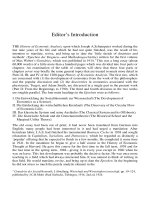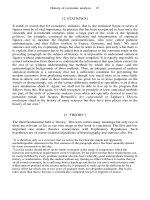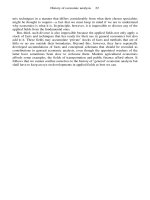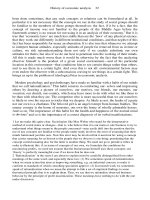Dessler HRM 12e ch 04 job analysis
Bạn đang xem bản rút gọn của tài liệu. Xem và tải ngay bản đầy đủ của tài liệu tại đây (1.69 MB, 46 trang )
Chapter 4
Job Analysis
Part Two | Recruitment and Placement
Copyright © 2011 Pearson Education, Inc.
publishing as Prentice Hall
PowerPoint Presentation by Charlie Cook
The University of West Alabama
LEARNING OUTCOMES
1. Discuss the nature of job analysis, including what it is
and how it’s used.
2. Use at least three methods of collecting job analysis
information, including interviews, questionnaires, and
observation.
3. Write job descriptions, including summaries and job
functions, using the Internet and traditional methods.
4. Write a job specification.
5. Explain job analysis in a “worker-empowered” world,
including what it means and how it’s done in practice.
Copyright © 2011 Pearson Education, Inc. publishing as Prentice Hall
4–2
WHERE WE ARE NOW…
Copyright © 2011 Pearson Education, Inc. publishing as Prentice Hall
4–3
The Basics of Job Analysis: Terms
• Job Analysis
The procedure for determining the duties and skill requirements
of a job and the kind of person who should be hired for it.
• Job Description
A list of a job’s duties, responsibilities, reporting relationships,
working conditions, and supervisory responsibilities—one
product of a job analysis.
• Job Specifications
A list of a job’s “human requirements,” that is, the requisite
education, skills, personality, and so on—another product of a
job analysis.
Copyright © 2011 Pearson Education, Inc. publishing as Prentice Hall
4–4
Types of Information Collected
Work
activities
Human
requirements
Information
Collected Via
Job Analysis
Job
context
Human
behaviors
Machines, tools,
equipment, and
work aids
Performance
standards
Copyright © 2011 Pearson Education, Inc. publishing as Prentice Hall
4–5
Uses of Job Analysis Information
Recruitment
and selection
EEO
compliance
Compensation
Information
Collected via
Job Analysis
Performance
appraisal
Discovering
unassigned duties
Training
Copyright © 2011 Pearson Education, Inc. publishing as Prentice Hall
4–6
FIGURE 4–1
Uses of Job Analysis Information
Job analysis
Job description
and specification
Recruiting
and selection
decisions
Performance
appraisal
Copyright © 2011 Pearson Education, Inc. publishing as Prentice Hall
Job evaluation—
wage and salary
decisions
(compensation)
Training
requirements
4–7
Steps in Job Analysis
Steps in doing a job analysis:
1
Decide how you’ll use the information.
2
Review relevant background information.
3
Select representative positions.
4
Actually analyze the job.
5
Verify the job analysis information.
6
Develop a job description and job specification.
Copyright © 2011 Pearson Education, Inc. publishing as Prentice Hall
4–8
FIGURE 4–2
Process Chart for Analyzing a Job’s Workflow
Copyright © 2011 Pearson Education, Inc. publishing as Prentice Hall
4–9
Collecting Job Analysis Information
Methods for Collecting Job Analysis Information
Interviews
Questionnaires
Copyright © 2011 Pearson Education, Inc. publishing as Prentice Hall
Observations
Diaries/Logs
4–10
Job Analysis: Interviewing Guidelines
• The job analyst and supervisor should work together
to identify the workers who know the job best.
• Quickly establish rapport with the interviewee.
• Follow a structured guide or checklist, one that lists
open-ended questions and provides space for answers.
• Ask the worker to list his or her duties in order
of importance and frequency of occurrence.
• After completing the interview, review and verify
the data.
Copyright © 2011 Pearson Education, Inc. publishing as Prentice Hall
4–11
Methods for Collecting Job Analysis
Information: The Interview
• Information Sources
• Interview Formats
Individual employees
Structured (Checklist)
Groups of employees
Unstructured
Supervisors with
knowledge of the job
• Advantages
Quick, direct way to find
overlooked information
• Disadvantage
Distorted information
Copyright © 2011 Pearson Education, Inc. publishing as Prentice Hall
4–12
Methods for Collecting Job Analysis
Information: Questionnaires
• Information Source
Have employees fill out
questionnaires to describe
their job-related duties and
responsibilities
• Questionnaire Formats
Structured checklists
Open-ended questions
Copyright © 2011 Pearson Education, Inc. publishing as Prentice Hall
• Advantages
Quick and efficient way
to gather information
from large numbers of
employees
• Disadvantages
Expense and time
consumed in preparing and
testing the questionnaire
4–13
FIGURE 4–3
Job Analysis Questionnaire for Developing Job Descriptions
Note: Use a
questionnaire like
this to interview job
incumbents, or have
them fill it out.
Copyright © 2011 Pearson Education, Inc. publishing as Prentice Hall
4–14
FIGURE 4–3
Job Analysis Questionnaire for Developing Job Descriptions (cont’d)
Copyright © 2011 Pearson Education, Inc. publishing as Prentice Hall
4–15
FIGURE 4–4
Example of Position/Job Description Intended for Use Online
Copyright © 2011 Pearson Education, Inc. publishing as Prentice Hall
4–16
FIGURE 4–4
Example of Position/Job Description Intended for Use Online (cont’d)
Copyright © 2011 Pearson Education, Inc. publishing as Prentice Hall
4–17
Methods for Collecting Job Analysis
Information: Observation
• Information Source
• Advantages
Observing and noting the
Provides first-hand
physical activities of
employees as they go
about their jobs by
managers.
information
Reduces distortion
of information
• Disadvantages
Time consuming
Reactivity response distorts
employee behavior
Difficulty in capturing
entire job cycle
Of little use if job involves a
high level of mental activity
Copyright © 2011 Pearson Education, Inc. publishing as Prentice Hall
4–18
Methods for Collecting Job Analysis
Information: Participant Diaries/Logs
• Information Source
Workers keep a
chronological diary or log
of what they do and the
time spent on each activity
• Advantages
Produces a more complete
picture of the job
Employee participation
• Disadvantages
Distortion of information
Depends upon employees
to accurately recall their
activities
Copyright © 2011 Pearson Education, Inc. publishing as Prentice Hall
4–19
Quantitative Job Analysis Techniques
Quantitative Job
Analysis
Position Analysis
Questionnaire
Department of
Labor (DOL)
Procedure
Copyright © 2011 Pearson Education, Inc. publishing as Prentice Hall
Functional Job
Analysis
4–20
FIGURE 4–5
Portion of a Completed Page from the Position Analysis Questionnaire
The 194 PAQ elements are
grouped into six dimensions.
This exhibit lists 11 of the
“information input” questions
or elements. Other PAQ
pages contain questions
regarding mental processes,
work output, relationships
with others, job context, and
other job characteristics.
Copyright © 2011 Pearson Education, Inc. publishing as Prentice Hall
4–21
TABLE 4–1
Basic Department of Labor Worker Functions
Copyright © 2011 Pearson Education, Inc. publishing as Prentice Hall
4–22
FIGURE 4–6
Sample Report Based on Department of Labor Job Analysis Technique
Copyright © 2011 Pearson Education, Inc. publishing as Prentice Hall
4–23
Internet-Based Job Analysis
• Advantages
Collects information in a standardized format from
geographically dispersed employees
Requires less time than face-to-face interviews
Collects information with minimal intervention or guidance
Copyright © 2011 Pearson Education, Inc. publishing as Prentice Hall
4–24
FIGURE 4–7
Selected O*NET General Work Activities Categories
Copyright © 2011 Pearson Education, Inc. publishing as Prentice Hall
4–25









